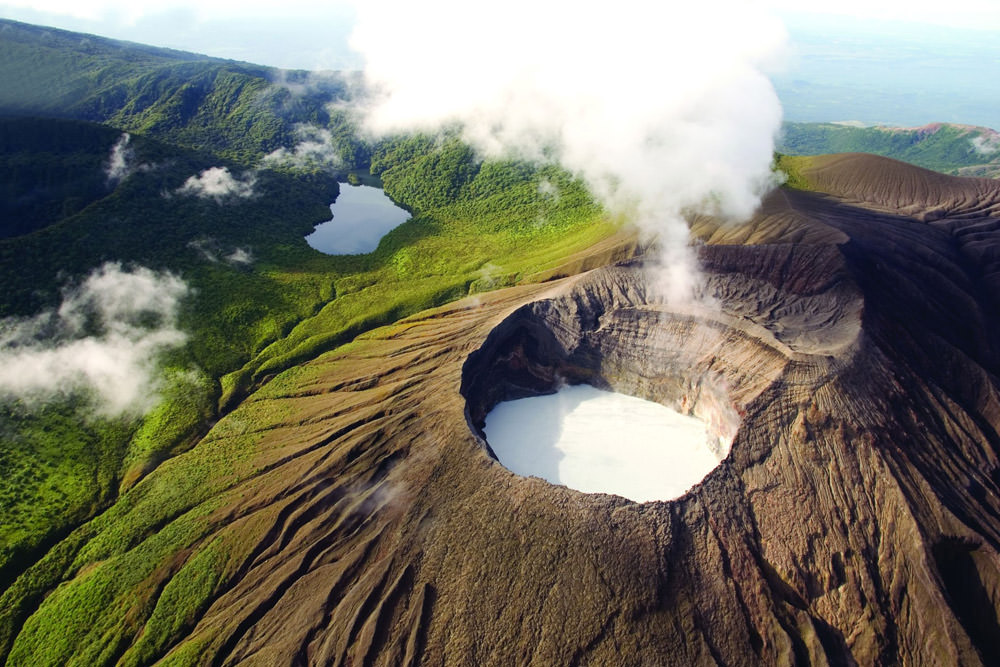
The Cordillera de Guanacaste, the provinces of Guanacaste and Alajuela, in the massif of the same name Rincon de la Vieja volcano, 27 km northeast of the city of Liberia. Las Pailas is located 25 km from Liberia and 10 km Curubandé. The Santa Maria area,
EXTENSION
14.083.9 hectares.
WEATHER
The average temperature is 26 ° C.
IMPORTANCE
One of the great benefits of this wilderness area is the protection of watersheds, as the Rincon de la Vieja massif is part of the boundary waters between the Caribbean and Pacific, the northeast of the country. In this area, born thirty-two rivers, including the Colorado, Blanco and drowning.
This park is probably the largest population in the wild of Guaria Morada, the national flower. Has great tourist potential due to the attractions they have, specifically the beautiful scenery and geological features.
ATTRACTIONS
The hot springs and panoramic views to the visitor in the park, which are very different from the dry forest of the lowland areas. The type of landscape that is more humid in the higher elevation and precipitation.
GEOLOGY
The massif of the Rincón de la Vieja, 1916 meters of altitude, is a composite structure. At the top we have identified nine eruptive points, and the other an active or inactive in the process of degradation. To the south of the crater is a lake of pure water.
The last strong eruption, with release of large clouds of ash and producing earthquakes and subterranean noises, occurred between 1966 and 1970. The most recent eruption occurred in 1983, 1984, 1991 and 1996. At present, the Rincon de la Vieja presents fumarole activity.
At the foot of the volcano’s southern side, there are areas called the Pailas and The Hornillas, covering an area of 50 ha. There are hot springs here, which give rise to streams of very hot water; solfatáricas gaps occupied by small depressions in which water continuously bubbling muddy, holes through which jets of steam are rising, particularly during the rainy season and mud in Volcancito varied forms and dimensions.
FLORA AND FAUNA
El Rincon de la Vieja presents diverse habitats due to differences in altitude and rainfall, the effect of volcanic eruptions and the type of slope. In the lower parts, some of the most common trees are the laurel, the guanaco, the Olive, the squirrels, naked indian, cedar and bitter Capulino white. In the intermediate parts of the massif, between 1200 and 1400 m, most abundant trees are the copey the curd, the Jicaro giving the papayillo, buried mouse, yos, the iguana, oak, and kills people – white cypress. Of up to 1400 meters near the summit, the forests are of low height and the trees are very branched and covered with moss and other epiphytes. The most common species here are: copey the papayillo the crepe. The top of the volcano is covered with ash and has little vegetation, some plants, are the copey the umbrella poor. The copey is sometimes forming nearly pure forests, where the cats, the tapirs, the gongolonas turkeys and black are very numerous. The park has seen over 300 species of birds: the calandria, the pavón, the goldfinch, the Oropéndola Montezuma, the river boat, the Curre tucancillo or green, the red widow, the hummingbird colidorado, or owl in the oropopo glasses, and fronted the lora Guaco.
Some of the mammals are the mountain goat, the peccary, the Guatuza the tolomuco, armadillo, Colmenero the bear, the sloth of two fingers and Congo monkeys, and red-faced. The insects are very abundant, are the beautiful morpho butterflies of which there are four species. In addition, there is more than 300 species of birds, among which are the pavón, the bobo bird, goldfinch and tucancillo mountain.
SERVICES
Visitor center, general information, gazebo, camping area, lunch area, waterfall trail.

 English
English






